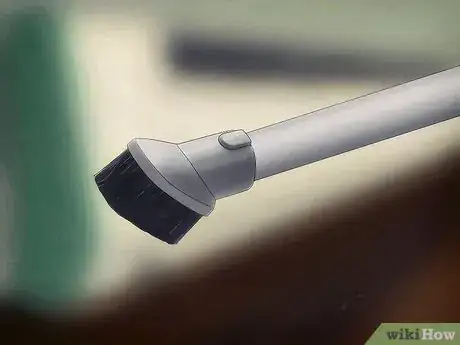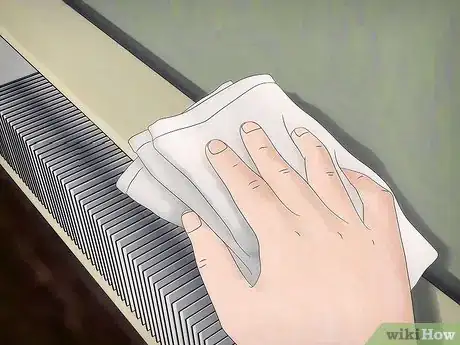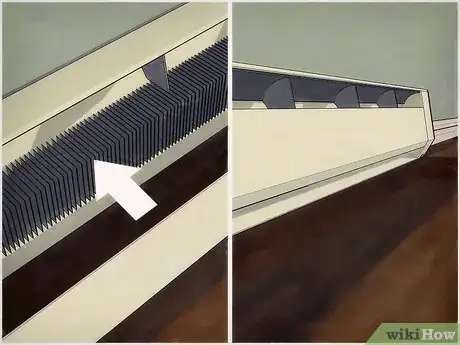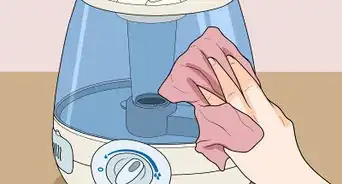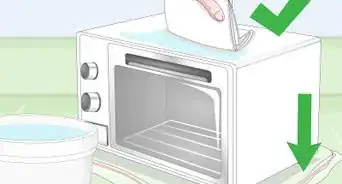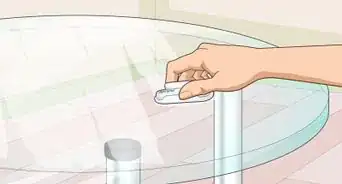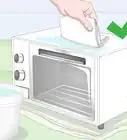This article was co-authored by Claudia & Angelo Zimmermann. Claudia and Angelo Zimmermann are the founders of Everneat, an Eco-Friendly Cleaning Service based in New York City and in Connecticut. They are also the founders of Clean Code, a DIY 100% natural cleaning product line.
There are 8 references cited in this article, which can be found at the bottom of the page.
This article has been viewed 48,694 times.
Though central heating has taken over as the most common method of warming living spaces, many older properties are still outfitted with electric or hot water radiators, and their owners can attest to how good a job they do. If you live in a house or apartment that makes use of baseboard radiators to generate heat, you’re going to want to make sure they’re running properly once it gets nippy outside. Luckily, cleaning a baseboard radiator unit takes no more than a few minutes, and only needs to be done a couple times a year.
Steps
Accessing and Preparing the Radiator Unit
-
1Turn off the power to the radiator.[1] Before you get started, find the main power control or shutoff valve for the baseboard radiator unit and switch it off. You may also want to turn your thermostat down to keep the temperature low just in case. The copper pipes circulating hot water through the radiator can get scalding hot, so don’t put yourself at any unnecessary risk while cleaning them.[2]
- Give the radiator several minutes to cool down before you open it up.
- Don’t attempt to clean the radiator until you’re certain it’s stopped circulating hot water.
-
2Clear away any nearby obstacles. Move everything out from in front of the radiator. This includes curtains, furniture and anything else that is blocking the unit or may get in your way during the cleaning process. Ideally, the hot air generated by the radiator should have as clear a path to warm the room as possible.
- It’s a good idea to keep your furniture dusted to prevent your baseboard radiators from getting so dirty in the future.
Advertisement -
3Remove the radiator cover.[3] Take the face plate cover off of the radiator unit. This can usually be accomplished by pulling the cover up from the bottom and lifting it off the groove where it rests on top. Set the cover aside until you’re finished cleaning.[4]
- Hold your hand a safe distance away from the pipes inside the radiator. This will help you determine whether it’s too hot to work on.
- One option is to place the radiator cover on the floor under the unit to collect whatever debris is shaken loose while cleaning. Just be sure to clean the cover separately before you put it back on.
-
4Identify the fins. Look inside the radiator. Along the length of the copper pipe that conducts hot water through your home you’ll find a collection of small, tightly-grouped aluminum squares lined up side-by-side. These are known as “fins,” and they play an important role in diffusing the heat created by the radiator. This is what you’ll be cleaning.[5]
- Most of the time, dust simply accumulates around the outer surface of the fins, meaning they just need a quick vacuuming.
Cleaning Inside the Radiator
-
1Ready a vacuum cleaner with a brush attachment. Take a vacuum cleaner or shop vac and slide on a brush-head attachment. This is the most efficient way to clean objects with complex construction and many irregular surfaces, like the inside of a radiator. The brush attachment will dislodge dust and debris on the fins, which can then be sucked up by the vacuum.
- You may be able to dust your unit without the use of a brush attachment (or with another device like a hand vacuum), but it will take longer and won’t be as thorough.
-
2Vacuum out the inside of the unit.[6] Turn on the vacuum and place your hand over the hose to make sure it’s getting proper suction. Run the brush head along the length of the radiator pipes and fins, using long, sweeping motions to collect as much dust as possible. Go over the fins as many times as you need to until you’re satisfied with their condition.[7]
- Brush around the fins in both directions, across the tops and down the sides.
- If your unit is particularly dirty, wipe away cobwebs, dust bunnies and clumps of hair with a dry cloth or paper towel before vacuuming.[8]
-
3Remove hard to reach debris with a separate brush. In some cases the bristles of the brush attachment may not be long enough to penetrate the spaces between the fins. If this is the case, use a separate tool, such as a slender paint brush or pipe cleaner, to work the stuck-on dust and dirt out of the deeper crevices of the unit’s innards.[9]
- Cleaning between the fins can be a tedious process, but it’s worth it to save yourself the expense of a poorly-running radiator.
- Some people claim to have had success loosening stubborn buildup with a spray bottle of water. This is not recommended, as it may cause rust or damage your unit.[10]
-
4Wipe down the radiator cover. Depending on how dirty the radiator cover face plate is, you might decide to clean it as well. Wet a washcloth with warm, soapy water. Scrub the inside of the cover to loosen any caked-on grime. Rinse and rewet the washcloth, then wipe away any remaining debris.
- This step will be especially important if you used your radiator cover to catch stray debris.
- Treat rusted metal covers with a rust-remover solution before replacing them.
-
5Replace the cover. Lift the cover and position so its back side faces the wall. Set the cover down in the groove at the top of the unit’s base, then lower it over the radiator until it fits back into place. It may click or snap to let you know it’s secure.
Keeping Your Baseboard Radiators Running Efficiently
-
1Clean your baseboard radiators regularly. To ensure that your baseboard radiators are working the way they’re supposed to, you should aim to clean them at least twice a year. Give them a good vacuuming at the start of the heating season (usually around late September or October) and again in early spring before you shut them off for the warmer months, checking them as needed in the meantime. Keeping the unit clear of dust will allow it to heat your home more efficiently.
- If you have pets that shed or live in a place with a high amount of dust buildup, you might want to clean your radiator units more frequently.
- Radiators that are well-maintained aren't forced to use as much energy, which means you’ll save money heating your home.
-
2Make sure the unit is unobstructed. Baseboard radiators work by pulling cold air up from floor level and filtering it through the heated fins, which quickly warm the air and circulate it back through the room. Help the process along by keeping all drapes, furniture and other belongings out of the way of the radiator. The area around the top and bottom of the unit should be kept clear so that air can pass through without difficulty.
- Be sure to keep the vents at the top of the radiator’s cover open to let warm air escape.
-
3Dust around your home. Keep your living space free of dust, especially around the baseboards and any furniture that happens to be close to your radiator. Dust from the surrounding environment can get sucked into the radiator as it draws in cool air from the room, and will quickly accumulate around the fins and other sensitive parts of the unit's interior. Frequent dusting is not just a good habit to get into, it can extend the life of your baseboard radiator and cut down on the number of tedious cleanings it requires.[11]
- Dust before your clean your radiator so that the loose particles floating around the room don't get pulled into the unit's air ducts.
- Don't just focus on visible dust. Be sure to vacuum your carpet, drapes and any other surface that might be harboring unseen dust.
-
4Replace damaged or broken parts. Over time, the fins along your radiator pipes, or the pipes themselves, may take a beating and need to be changed out. Call your heating and air specialist and ask for an estimate for the installation of new pipes or fins if you notice that yours are bent, ruptured or otherwise damaged. The fins do most of the work of putting off the heat generated by the hot water pipes, so it’s important that they stay in good working order.[12]
- Unless you’re experienced in radiator repair, it’s not recommended that you try to replace fin-tubing yourself.
- The metal fins increase the surface area used to conduct heat from the pipes, warming the room at a much faster rate.
Warnings
- During and shortly after operation, the pipes inside a baseboard radiator get extremely hot. To avoid injury, make sure the main power is turned off, or the shutoff valves are completely closed, before attempting to clean. If you do get burned, call emergency medical services right away.⧼thumbs_response⧽
- Never use a liquid cleaning solution to clean any part of your radiator. Not only can they cause rust, they could also be harmful to breathe when evaporated into the air.⧼thumbs_response⧽
Expert Interview
Thanks for reading our article! If you'd like to learn more about cleaning baseboard radiators, check out our in-depth interview with Claudia & Angelo Zimmermann.
References
- ↑ https://todayshomeowner.com/how-to-clean-baseboard-heaters/
- ↑ https://www.youtube.com/watch?v=B7ElJvSKYeM
- ↑ https://www.aconcordcarpenter.com/how-to-clean-baseboard-heater-fins.html
- ↑ https://www.youtube.com/watch?v=sOZyeCxUbTw
- ↑ https://www.doityourself.com/stry/how-do-hot-water-baseboard-heaters-work
- ↑ https://todayshomeowner.com/how-to-clean-baseboard-heaters/
- ↑ https://www.youtube.com/watch?v=B7ElJvSKYeM
- ↑ http://www.yesmagazine.org/issues/government-of-the-people-shall-not-perish/yes-but-how
- ↑ https://www.aconcordcarpenter.com/how-to-clean-baseboard-heater-fins.html




